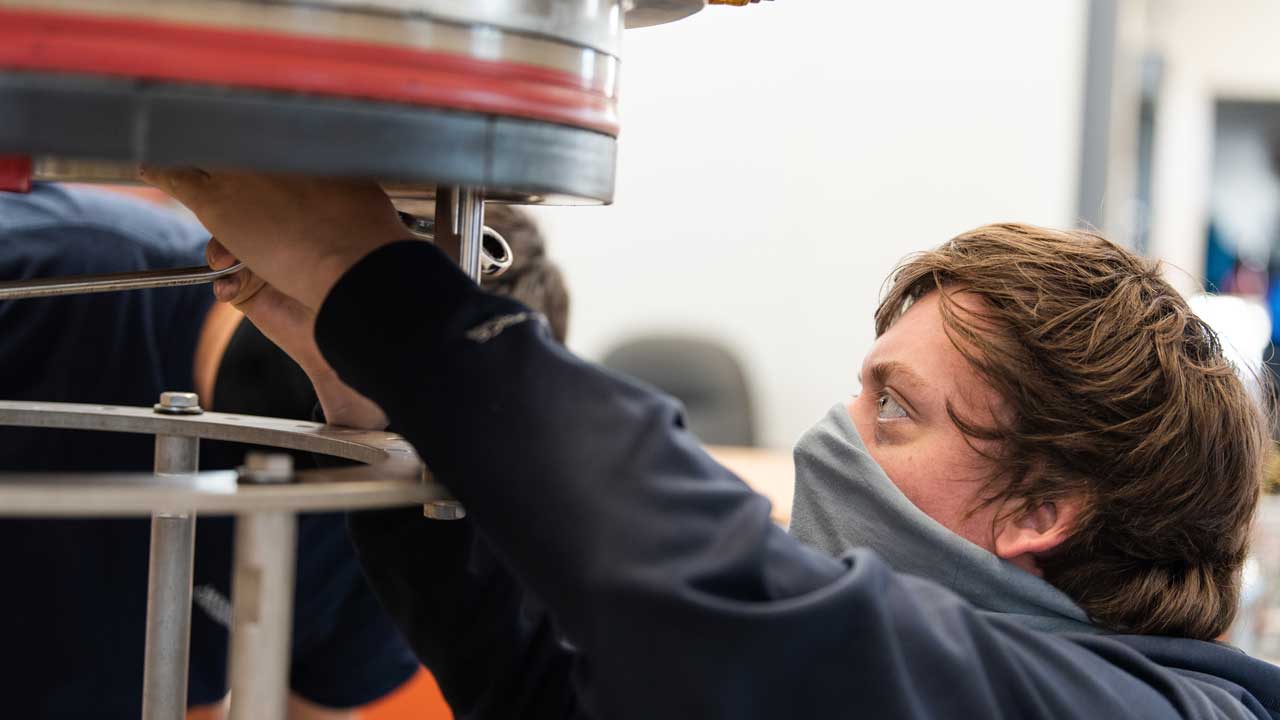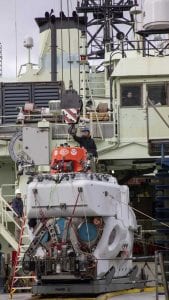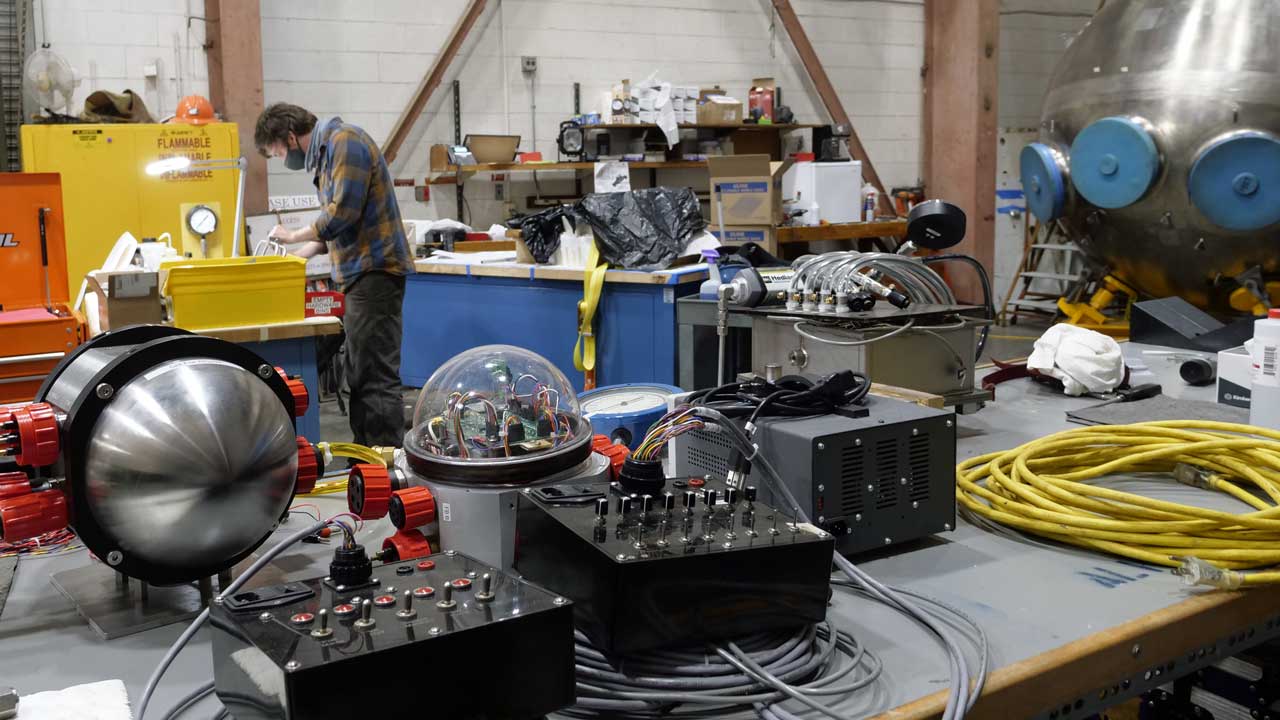Meet the Alvin 6500 Team: Danik Forsman
An Alvin pilot and mechanical section leader on building a sub with his own hands
By Hannah Piecuch | January 21, 2021

During an overhaul period, members of the Alvin Group who spend most of their time at sea return to WHOI to work closely with the shore-based operations team. The same people who pilot and maintain human-occupied vehicle Alvin during cruises, take it apart, inspect each part, and repair or upgrade anything that needs work. Danik Forsman is the mechanical section leader of the group, the most senior person responsible for maintaining the sub’s mechanical systems while at sea. He is also an Alvin Pilot. He took some time to tell Oceanus what the overhaul looks like for him and how a series of apprenticeships has given him a unique path to his current position.
Oceanus: When it is not an overhaul period, what does your work look like?
Danik: I go to sea with Alvin about five months a year and oversee all the mechanical maintenance for the sub and several mechanical techs. I am also a pilot and am in the sub every third dive day. My job piloting the varies: photographic work, surveying, mapping, sampling, recovering, or deploying stuff. The terrain varies wildly. Sometimes you’re in volcanically-active sites with super-heated vents or exploring deep sea valleys. You’re kind of in this all-terrain vehicle. I also interface with the chief scientist on each cruise to make sure that they're getting what they need.
We have the launch and recovery of the vehicle on a daily basis. And then there's all the other random jobs. Alvin is a working prototype. Even though we're doing this big upgrade now, every year leading up to this we were swapping new parts and new systems and testing things to get data to be able to design for the future. It’s a team effort, the ship crew, scientists, Alvin, is all one big cohesive team. We’re all here to support science.

Alvin Pilot and Mechanical Section Leader Danik Forsman securing the crane hook to Alvin while offloading the sub from R/V Atlantis in March. Alvin Group Manager Bruce Strickrott, left. (Jayne Doucette © Woods Hole Oceanographic Institution)
Oceanus: You don’t have a formal background in mechanical engineering, but you’re a pilot and one of the senior members of the team that maintains Alvin. How did you get where you are today?
Danik: My background is in commercial diving. I’ve had a lot of mentors in the ten years I've been at WHOI. My first job here was a temporary contract that turned into a permanent position. After a couple years I started working as a primary diver under Ed O'Brien who is the divemaster here. I would get sent out around the world to do whatever projects were going on at the time, in Japan or Canada or Scotland, wherever. And I would oversee the diving part of a scientific project.
But I got to a point when I was 25 and diving every single day that it started taking a toll on my joints and nervous system. At that time the Alvin Group had an opening for a junior mechanic. I started out as a tech and went through a provisionary period to show that I was serious, and then they entered me into the pilot-in-training program.
Oceanus: What was becoming a pilot like?
Danik: The Alvin Group has a very stringent system of qualifying people. It’s very much based on a person's personality, their maturity, their ability to handle stress. When it came time to qualify as a pilot, my career thus far had built me up for that. A lot of it came from working with Ed O'Brien. I have to give him a lot of credit because he was definitely one of the people who helped sculpt me into the right mindset for dealing with tense situations underwater. And then on the mechanical engineering front, I was apprenticed under Jefferson Grau, who was the mechanical section leader when I was hired.
Because I don't have an engineering degree, I had to teach myself everything I needed to know to be able to pass my engineering board: the basics of electrical engineering, mechanical engineering, materials, everything I could. One cool thing about Alvin is that it is a really old program. We have this crazy archive of information, so I was digging through all these old pilot board notes reading stuff from the 60s and 70s.
I was the first pilot since the last overhaul. It had been years since they had made a new Alvin pilot. The program itself goes through just as much change as the sub itself. We are constantly adapting to new times, conditions, and personnel. There is a very serious understanding that this whole thing runs on trust. It’s high stakes right off the bat.

Oceanus: What are some of the projects you’re working on during this overhaul?
Danik: This is a sequential project. In March when the sub came back my job was to oversee the mechanical teardown. We tore the sub down to a naked frame, got rid of all of the 4,500-meter components, and sent out the 6,500-meter components for repair. Then we proceeded to do inspections on the sphere and frame.
This overhaul has a lot of mechanical work. There are some electrical upgrades, too, but all of the major mechanical systems are getting completely replaced. We’re going to have a brand-new hydraulic system, variable ballast, main ballast, trim. At the moment my job has been testing the new variable ballast pump. I'm working on that for the new pump with the lead mechanical engineer Fran Elder. We work hand in hand on all of these projects.
The frame will come back at the end of February and then we can actually start putting the sub together.
Oceanus: What are you most looking forward to in this overhaul process?
Danik: When we actually start to reassemble Alvin. We are going to start with an empty frame and then walk out of here with a 6,500-meter rated vehicle that's ready to go back to work. It will be very satisfying to see it come together. I will build a large part of this sub with my own hands.
After this there's the qualification dives and sea trails. There are subs in the world that have gone to deeper depths, but one thing that sets Alvin apart is that it is a working vehicle. We go down and recover pieces of the Earth and come back up to the surface and do that for twenty days straight.
The other thing I'm really looking forward to is training new pilots. The next cohort of pilots-in-training are all totally different ages from totally different backgrounds. I had a great time going through the program and becoming a pilot. It will be really satisfying to train this new generation of pilots.
Oceanus: What is your favorite thing about Alvin?
Danik: It’s the idea of Alvin that I find most compelling. Not the vehicle, not the machinery, but the adventure and exploration and vision that WHOI has for leading the way.
We're taking people down to the seafloor and coming back same day. In the morning you have breakfast on the ship, which you have been doing for twenty days. It's the same people, same food, same place. And then you drive down to this science-fiction environment. It's hard to believe this exists. You see these amazing things that will help you do great science and then you come back. And then you're having dinner right in the same place, same food, same people. And you say “Wait. What did I just do? I was 4,000 meters under the ship working on an active volcano.”
That is what keeps me interested and focused on this work.
Human-occupied vehicle Alvin is in Woods Hole for the final phase of an overhaul that will enable the sub to travel 6,500 meters below the sea surface—more than 4 miles deep and 2,000 meters deeper than Alvin’s current maximum depth. Alvin is owned by the U.S. Navy, operated by the National Deep Submergence Facility at WHOI, and funded by the National Science Foundation, the Office of Naval Research, and the National Oceanic and Atmospheric Administration. Operations are coordinated through the University-National Oceanographic Laboratory System.
